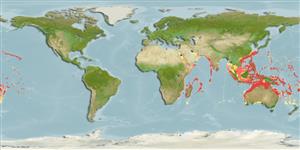Ikan bertulang rawan (sharks and rays) >
Carcharhiniformes (Ground sharks) >
Carcharhinidae (Requiem sharks)
Etymology: Carcharhinus: Greek, karcharos = sharpen + Greek, rhinos = nose (Ref. 45335).
Lingkungan / Klimat / Range
Ekologi
; laut berasosiasi dengan karang; oceanodromus (Ref. 51243); kisaran kedalaman 0 - 1000 m (Ref. 55178), usually 0 - 280 m (Ref. 6871). Tropical, preferred ?; 29°N - 35°S, 33°E - 151°W (Ref. 55178)
Indo-West Pacific to Central Pacific: Madagascar and the Mauritius-Seychelles area to Tuamoto Archipelago; north to southern China; south to northern Australia.
Length at first maturity / Size / Weight / umur
Maturity: Lm 132.3, range 122 - 137 cm
Max length : 255 cm TL jantan/; (Ref. 2334); 172.0 cm TL (female); Berat maksimum terpublikasi: 33.7 kg (Ref. 4699); Umur maksimum dilaporkan: 25 Tahun (Ref. 37816)
Duri punggung (Keseluruhan (total)): 0; duri punggung lunak (Keseluruhan (total)): 0; Duri dubur 0; Sirip dubur lunak: 0. Dark grey or bronze-grey above, white below; caudal fin with a conspicuous wide black posterior margin; undersides of pectoral and pelvic fins with black tips and posterior margins, but fins otherwise not conspicuously black or white-tipped except for white-tipped first dorsal in some individuals (Ref. 9997).
Occurs on continental and insular shelves and oceanic waters adjacent to them (Ref. 244). Common on coral reefs, often in deeper areas near drop-offs to the open sea, in atoll passes, and in shallow lagoons adjacent to areas of strong currents (Ref. 244). Coastal-pelagic near the bottom, near drop-offs at 1-275 m (Ref. 58302). Forms daytime schools or aggregations in favored areas (Ref. 244). Although active during the day, it is more active nocturnally (Ref. 244). Viviparous, with 1-6 pups (Ref. 37816). Feeds on reef fishes, squids, octopi, crabs, lobsters and shrimps (Ref. 244, 5578). Tends to be aggressive under baited conditions (Ref. 6871) and readily enters into a frenzy feeding pattern, at which time it may become quite dangerous. Repeatedly incriminated in human attacks. Utilized for human consumption, fishmeal, and other shark products. Minimum depth from Ref. 6871. Maximum length of female taken from Ref. 5213.
Viviparous, placental (Ref. 50449). 1-6 pups in a litter (Ref. 244). Gestation period about 12 months (Ref. 244). Size at birth 50 to 60 cm (Ref. 26346, 37816) or 75 cm (Ref. 244). Distinct pairing with embrace (Ref. 205).
Compagno, L.J.V., 1984. FAO Species Catalogue. Vol. 4. Sharks of the world. An annotated and illustrated catalogue of shark species known to date. Part 2 - Carcharhiniformes. FAO Fish. Synop. 125(4/2):251-655. Rome: FAO. (Ref. 244)
Status IUCN Red List (Ref. 115185)
CITES (Ref. 94142)
Not Evaluated
ancaman kepada manusia
Traumatogenic (Ref. 4716)
penggunaan manusia
Perikanan: nilai komersial kecil; Ikan buruan: ya
informasi lanjut
AcuanBudidaya airprofil budidaya airStrainGenetikaFrekuensi alelDiturunkanPenyakit-penyakitPengolahanMass conversion
Alat, peralatan
laporan khas
muat turun XML
Sumber internet
